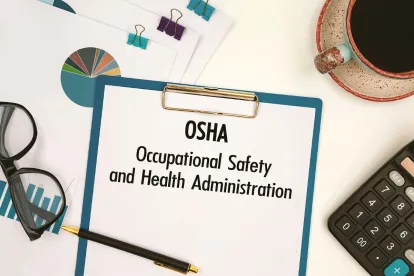On August 30, 2023, the Occupational Safety and Health Administration (OSHA) published a proposed rule that would change the scope of who would be allowed to participate in walkarounds conducted as part of OSHA inspections. Specifically, the proposed rule would modify 29 C.F.R. § 1903.8(c) to expand the definition of what types of “third parties,” such as community activists and union representatives, may accompany a Compliance Safety and Health Officer (CSHO) during an OSHA inspection. The public comment period for the proposed rule ends on October 30, 2023.”
Quick Hits
- OSHA has issued a proposed rule that would change the scope of who would be allowed to participate in walkarounds conducted as part of OSHA inspections.
- OSHA stated in a January 2023 announcement that its rulemaking will “clarify the right of workers and certified bargaining units to specify a worker or union representative to accompany an OSHA inspector during the inspection process/facility walkaround, regardless of whether the representative is an employee of the employer.”
- The comment period ends on October 30, 2023.
To understand the full history behind why rulemaking on this topic has been a priority for OSHA, read our previous discussion surrounding the Fairfax Memo, a standard interpretation related to Occupational Safety and Health (OSH) Act regulations at 29 C.F.R. § 1903.8(c). However, one does not need to look back far to understand OSHA’s current position on this topic. In its January 4, 2023, announcement, OSHA stated the following:
This rulemaking will clarify the right of workers and certified bargaining units to specify a worker or union representative to accompany an OSHA inspector during the inspection process/facility walkaround, regardless of whether the representative is an employee of the employer, if in the judgment of the Compliance Safety and Health Officer such person is reasonably necessary to an effective and thorough physical inspection.
As a reminder, 29 C.F.R. § 1903.8(c) reads as follows:
The representative(s) authorized by employees shall be an employee(s) of the employer. However, if in the judgment of the Compliance Safety and Health Officer, good cause has been shown why accompaniment by a third party who is not an employee of the employer (such as an industrial hygienist or a safety engineer) is reasonably necessary to the conduct of an effective and thorough physical inspection of the workplace, such third party may accompany the Compliance Safety and Health Officer during the inspection.
The proposed rule would modify 29 C.F.R. § 1903.8(c) with the addition of eleven words:
(c) The representative(s) authorized by employees may be an employee of the employer or a third party. When the representative(s) authorized by employees is not an employee of the employer, they may accompany the Compliance Safety and Health Officer during the inspection if, in the judgment of the Compliance Safety and Health Officer, good cause has been shown why their participation is reasonably necessary to the conduct of an effective and thorough physical inspection of the workplace (e.g., because of their relevant knowledge, skills, or experience with hazards or conditions in the workplace or similar workplaces, or language skills).
The ability to determine whether individuals meet this new criterion still solely rests with the CSHO conducting the inspection. The authority under 29 C.F.R. § 1903.8(b) grants CSHOs the “authority to resolve all disputes as to who is the representative authorized by the employer and employees for the purpose of this section. If there is no authorized representative of employees, or if the Compliance Safety and Health Officer is unable to determine with reasonable certainty who is such representative, he shall consult with a reasonable number of employees concerning matters of safety and health in the workplace.” However, this authority is given without any oversight. Neither the current standard nor the proposed rule provides guidance on how these determinations made by individual CSHOs are checked for consistency with the standard. As drafted, the new rule will leave employers with no recourse, short of refusing an inspection, if a CSHO selects someone to accompany him or her on the inspection whom the employer vehemently objects to joining the inspection.
Now, as the comment period opens, the proposal poses several questions to employers. Most notably, what does the phrase “reasonably necessary to the conduct of an effective and thorough physical inspection of the workplace” mean? For example, would this proposed rule allow community activists and union representatives not associated with the workforce to enter the inspection location? Would it allow attorneys for injured or deceased employees to enter the workplace? Would it allow a competitor with a friendly relationship with the employees or the CSHO into the workplace? Based on content in the preamble to the new rule, it would appear that the answer to all of these questions is in the affirmative.
A nonemployee allowed to enter the workplace would have a unique opportunity to access information otherwise not available and develop relationships that could facilitate organizing campaigns, political activity, and litigation. This proposal also raises the question of whether OSHA would consider it reasonably necessary that these third parties be allowed to participate in OSHA’s private interviews with employees and have access to the management interviews. This potential increase in access to information would not only impact campaigning, litigation, and potentially adverse political activity, but has historically had a direct impact on the number of OSHA complaints raised in a workplace.
It is clear that the rule, if finalized as proposed, will insert instability and unpredictability into the inspection process. That same instability is exactly why it is anticipated that there will be much litigation surrounding this issue. In the meantime, it remains to be seen how employers, labor, and other interested parties respond to this notice with comments and litigation.



 />i
/>i

